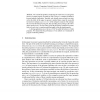770 search results - page 27 / 154 » Subsequence similarity language models |
BIBE
2007
IEEE
14 years 2 months ago
2007
IEEE
—The rapid burgeoning of available protein data makes the use of clustering within families of proteins increasingly important, the challenge is to identify subfamilies of evolut...
JISBD
2000
13 years 9 months ago
2000
A Natural Language Interface for Databases allows users of multimedia kiosks to formulate natural language questions. User questions are first translated into a logic language and ...
ASPLOS
2008
ACM
13 years 10 months ago
2008
ACM
Industry vendors hesitate to disseminate proprietary applications to academia and third party vendors. By consequence, the benchmarking process is typically driven by standardized...
CP
2009
Springer
14 years 9 months ago
2009
Springer
We consider the problem of exploring the search tree of a CLP goal in pursuit of a target property. Essential to such a process is a method of tabling to prevent duplicate explorat...
CORR
2006
Springer
13 years 8 months ago
2006
Springer
Currently many different modeling languages are used for workflow definitions in BPM systems. Authors of this paper analyze the two most popular graphical languages, with highest p...

